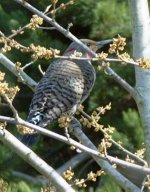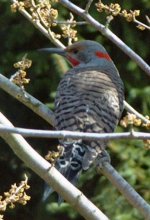alancairns
Well-known member
This flicker was in my garden in February. It has a red malar stripe, and a red nape. It is definitely red-shafted, though this isn't apparent in the pictures. According to Sibley, there should be no red nape. A yellow-shafted should show a red nape, but a black malar. Is this some kind of intergrade?
We are deep in red-shafted territory here -- the nearest yellow-shafteds are probably in Alberta.
Alan
We are deep in red-shafted territory here -- the nearest yellow-shafteds are probably in Alberta.
Alan






